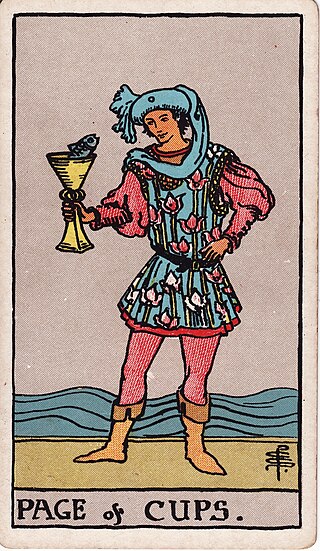
The Six of Wands, or Six of Batons, is a card used in Latin-suited playing cards, which include tarot decks. It is part of what tarot card readers call the "Minor Arcana," the six of wands cards in divination decks with illustrated pip cards, displays a laureled horseman bearing a staff adorned with laurel crown. Footmen with staves are at his side.

The Page of Wands is a card used in Latin-suited playing cards which include tarot decks. It is part of what tarot card readers call the Minor Arcana.

Knight of Wands or Knight of Batons is a card used in Latin-suited playing cards which include tarot decks. It is part of what tarot card readers call the Minor Arcana. Tarot cards are used throughout much of Europe to play tarot card games.

The Queen of Wands is a court card in the Minor Arcana set of the tarot.

The Ace of Cups is a card used in Latin-suited playing cards. It is the ace from the suit of cups. In Tarot, it is part of what card readers call the "Minor Arcana", and as the first in the suit of cups, signifies beginnings in the area of the social and emotional in life.

The Page of Cups is a card used in Latin-suited playing cards which include tarot decks. It is part of what tarot card readers call the "Minor Arcana"

The Knight of Cups is a card used in Latin-suited playing cards, including tarot decks. It is part of what tarot card readers call the "Minor Arcana".

The Knight of Swords is a card used in Latin-suited playing cards which include tarot decks. It is part of what tarot card readers call the "Minor Arcana".

The Queen of Swords is a card in the suit of swords, part of the Minor Arcana set of the tarot.

The Three of Coins is the third card in the suit of coins. The suit is used in Spanish, Italian, and tarot decks.

Five of Coins is a card used in Latin-suited playing cards which include tarot decks. It is part of what tarot card readers call the "Minor Arcana".

The Six of Coins, or Six of Pentacles, is a card used in Latin-suited playing cards which include tarot decks. It is part of what tarot card readers call the "Minor Arcana".

Eight of Coins is a card used in Latin-suited playing cards which include tarot decks. It is part of what tarot card readers call the "Minor Arcana"

Nine of Coins is a card used in Latin-suited playing cards which include tarot decks. It is part of what tarot card readers call the "Minor Arcana" and represents a financially independent aristocrat.

Page of Coins is a card used in Latin-suited playing cards which include tarot decks. It is part of what tarot card readers call the "Minor Arcana".

King of Coins is a card used in Latin-suited playing cards. It is the king from the suit of coins. In Tarot, it is part of what tarot card readers call the "Minor Arcana".

The Queen of Coins, also known as the Queen of Pentacles, is a card used in Latin-suited playing cards. It is the queen from the suit of coins. In tarot, it is part of what tarot card readers call the "Minor Arcana".

The suit of coins is one of the four suits used in tarot decks with Latin-suited cards. It is derived from the suit of coins in Italian and Spanish card playing packs.

The suit of wands is one of four suits in tarot, collectively known as the Minor Arcana. Like the other tarot suits, the suit of wands contains fourteen cards: ace (one), two through ten, page and knight, queen and king. When Tarot cards are to play Tarot card games, where wands corresponds to the suit of batons. Tarot cards came to be utilized for divinatory purposes by esotericists such as Eliphas Levi and were regularized into the divinatory form most known today by the Hermetic Order of the Golden Dawn and the Rider–Waite Tarot, created by a Golden Dawn member.

The suit of cups is one of four suits of tarot which, collectively, make up the Minor Arcana. They are sometimes referred to as goblets and chalices. Like the other suits of the Minor Arcana, it contains fourteen cards: ace (one), two through ten, page, knight, queen and king. Historically, the suit represented the First Estate. Tarot cards were originally designed for card play and are still used throughout much of Europe to play various Tarot card games. However, in English-speaking countries, where the games are largely unknown, Tarot cards came to be utilized primarily for divinatory purposes. In modern card games, the equivalent suits are Hearts or Cups.




















